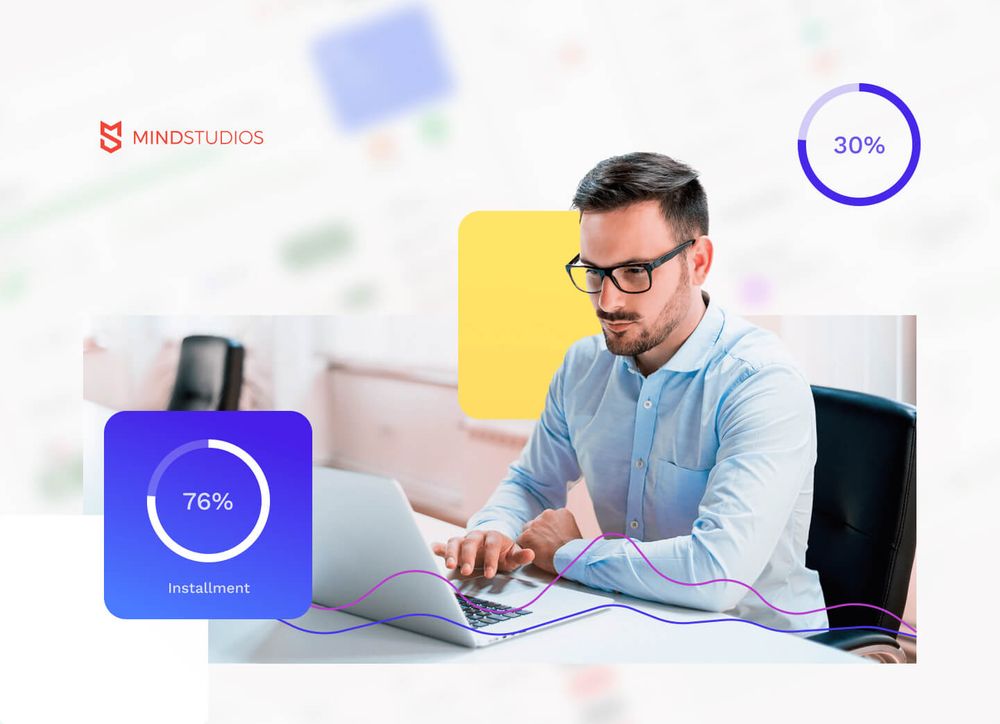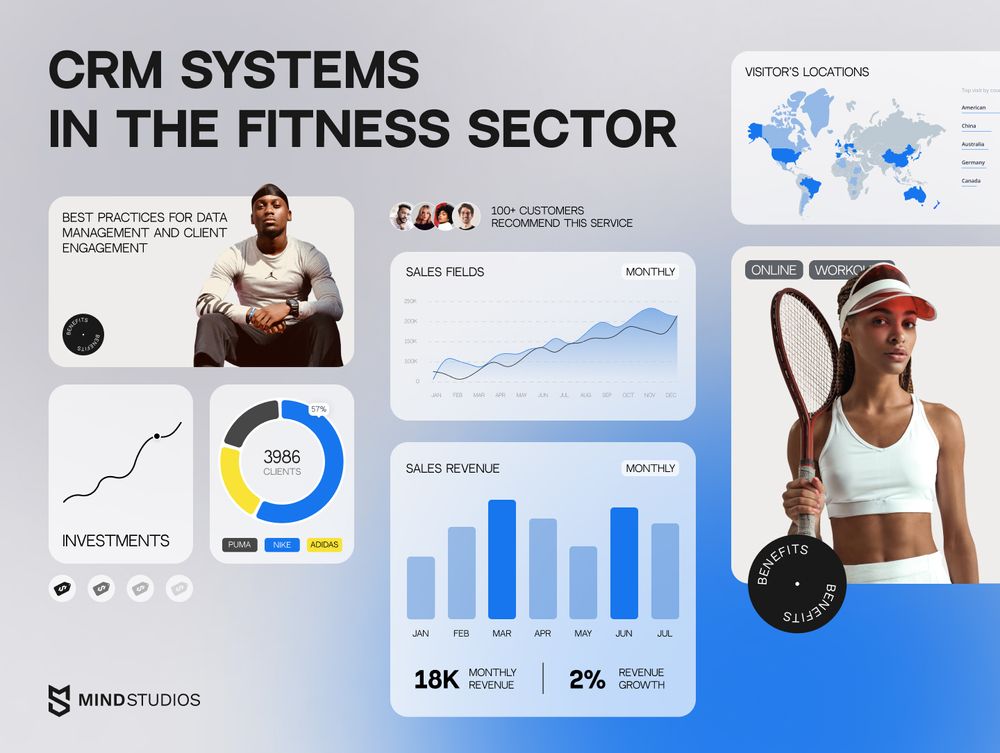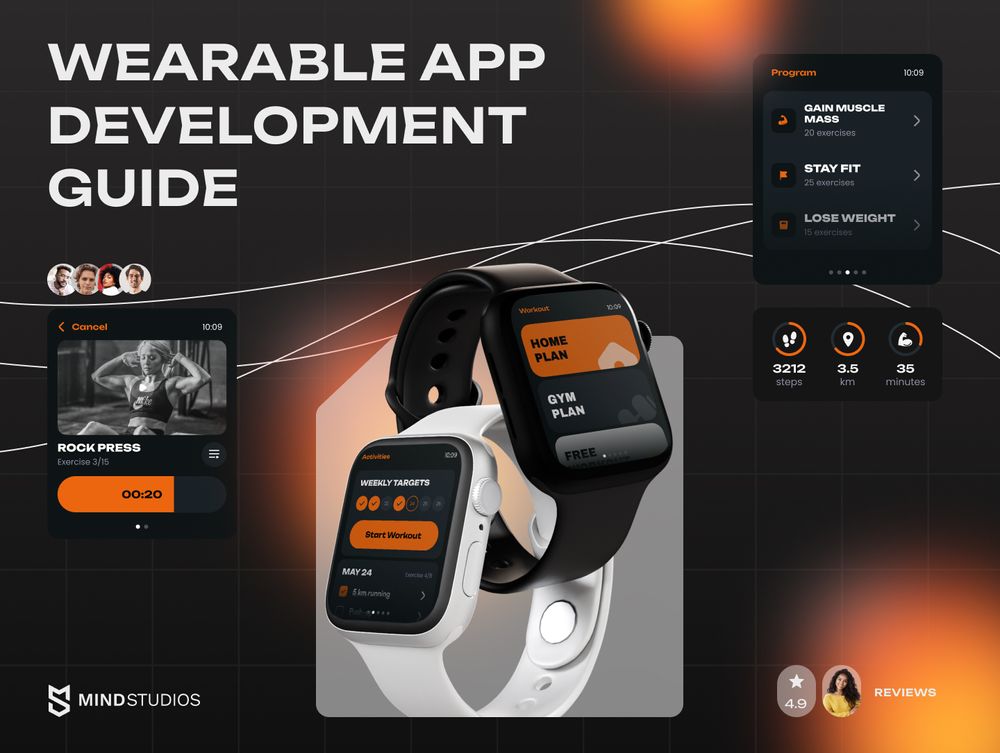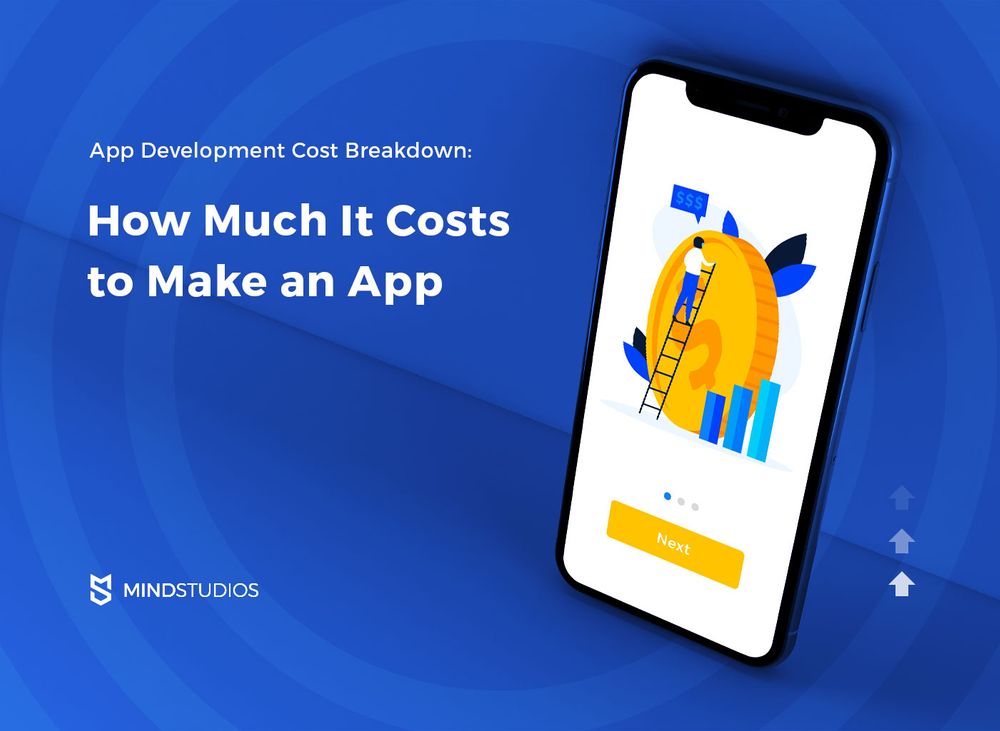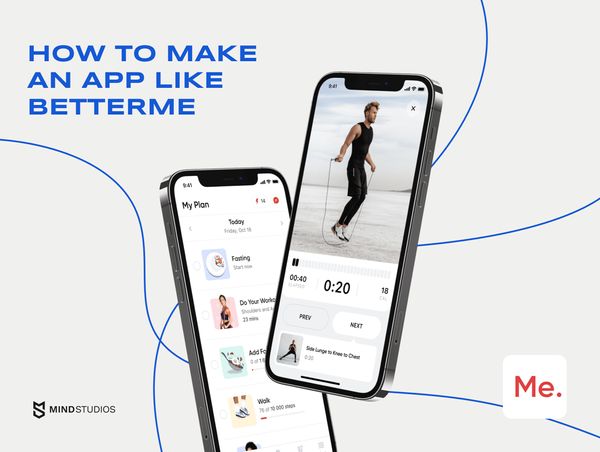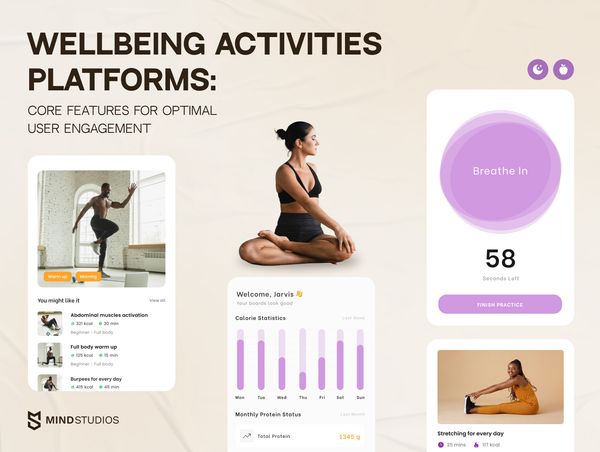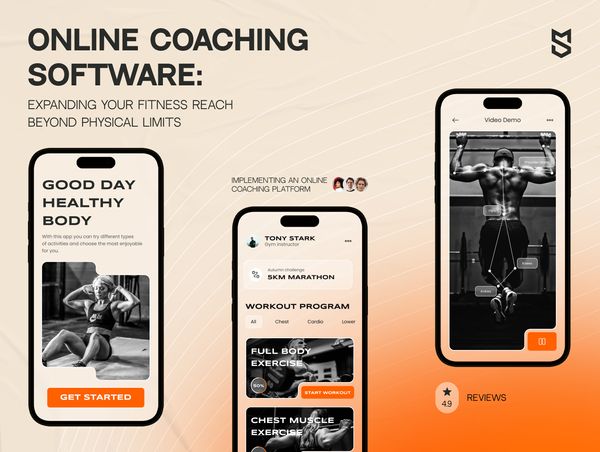
Highlights:
- Remote coaching software transforms fitness coaching by removing limits and restrictions of traditional gyms, providing tailored training, and encouraging continuous contact and support between coaches and users.
- Fitness professionals can leverage online coaching programs to reach a bigger audience, diversify revenue sources, and optimize services by integrating digital and in-person offers.
- Implementing a comprehensive online coaching platform simplifies fitness program creation, evaluation, and client management by offering a centralized platform for coaches and fitness-oriented businesses to build customized exercise programs, maintain client profiles, and easily schedule sessions.
Helping customers stay motivated and on track to reach their fitness goals is the primary responsibility of personal coaches. Coaching software implementation can help trainers or fitness brands fulfill this responsibility.
Coaches often worry that relying on a digital platform might weaken personal connections with clients, reduce engagement, and lower the quality of their interactions.
According to our clients, online coaching software really presents a chance for growth rather than a risk. We have included implementation tips and coaching online platform development best practices in this article to ensure you get the most out of these solutions.
At Mind Studios, we understand all the caveats associated with such an implementation since we worked on multiple fitness platforms, including an online remote coaching system – Fitr. If you're ready for a drastic transformation – you can leverage our expert guidance in this journey. Schedule a free consultation to find out how we can assist you in creating a solution specifically suited to your requirements.
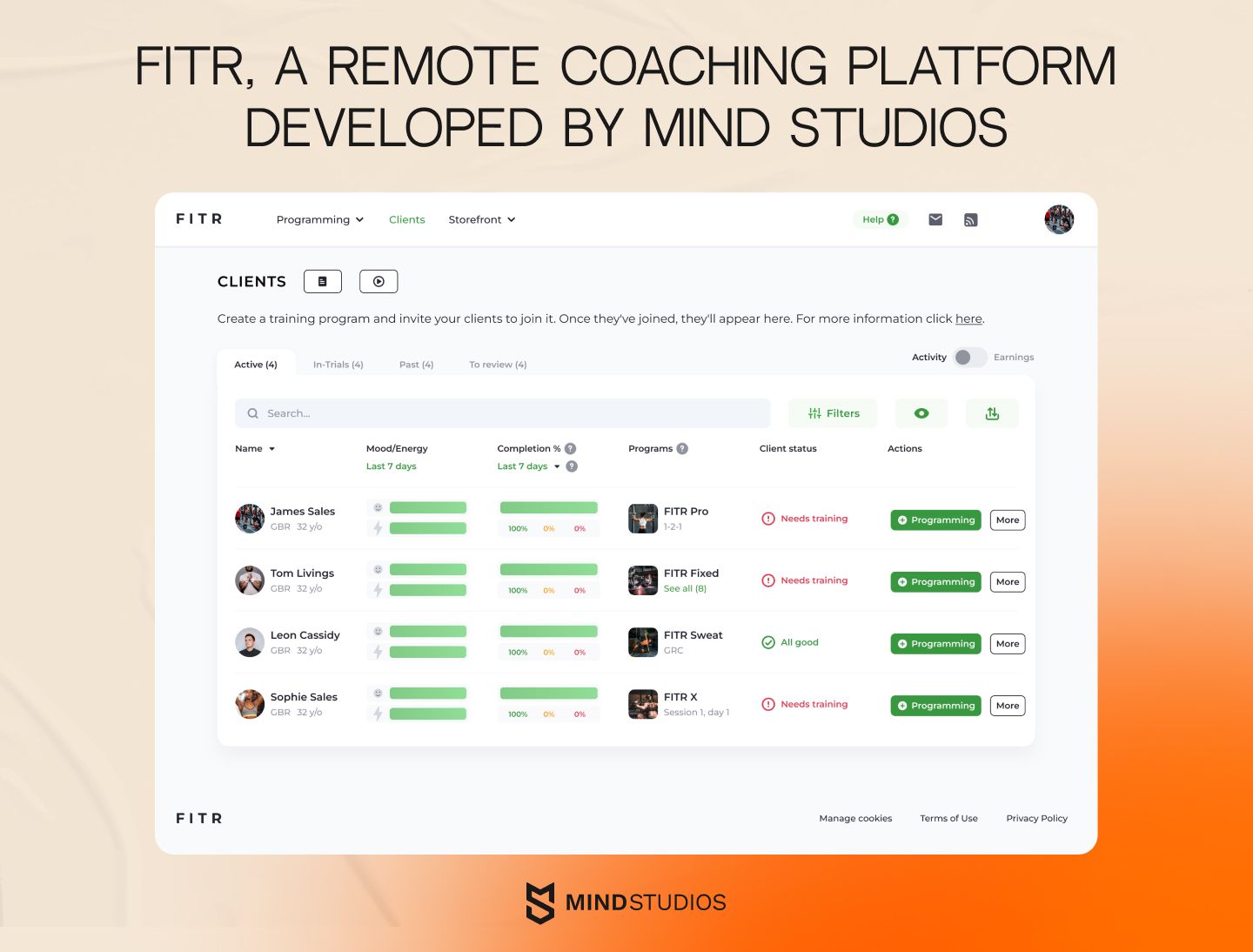
Inside the process of online coaching platform development
Remote coaching software can help fitness business owners and coaches reach more people, work more efficiently, improve user loyalty, and earn money without actively doing more than usual. Subscription fees, transaction fees, and partnerships are other ways that business owners can earn revenue from such a solution. In addition to recruiting additional trainers and clients, the software can scale, monetize user data, and, more importantly – develop into a valued brand.
The impact of coaching software depends on how you approach the development process. Here's how we at Mind Studios recommend going through this process:
Discovery stage
Our team aims to deliver digital products that eventually become well-running businesses. That’s why we recommend starting the development of a remote coaching solution with a discovery phase where you should focus on:
- Creating a fitness app vision that specifies problems, solutions, and requirements
- Choosing acquisition channels, your app's unique value proposition
- Performing competitor and market analysis to ensure that a fitness app will be distinct
At this initial stage, your app development team conducts preliminary market research to determine whether your remote coaching app idea is marketable and, if not, how to make it so.
Gyms and coaches might use this phase to envision how a remote coaching service can extend their reach beyond physical locations, drawing in more clients and maybe boosting income sources. At the end of the discovery stage, you will receive a low-fidelity coaching app prototype, which is required to ensure that all stakeholders share a common vision.
Market research and idea validation
We recommend conducting thorough market research and validating your idea for the brand-new products. At this stage, you have to assess the idea's viability and market demand to address any concerns left after the discovery stage.
Conducting extensive market research and validation ensures that your coaching app concept meets a real need, aligns with industry trends, and offers unique value. It's also a good idea to prioritize transparency and collaborate closely with stakeholders early on. With careful study, fitness professionals and business owners can identify market gaps and opportunities, allowing them to customize their coaching services to meet evolving customer demands.
Strategic planning and risk mitigation
We understand the importance of strategic planning and gradual development in reducing financial risks. By breaking the project into manageable stages and prioritizing essential features, you can maximize budget efficiency and allow for potential changes.
Through a phased approach to development, gym owners and fitness professionals can reduce financial risks by prioritizing items that offer users instant benefits. This progressive approach allows them to optimize the budget and adapt to market input.
Continuous feedback loops and rapid prototyping are also crucial to the iterative development method. For instance, this approach enables us to make course corrections and enhancements based on valuable real-world insights.
Choose a development team for your online coaching software
Selecting the ideal development team for your online fitness coaching platform can make all the difference in its success. Before making the final choice, we advise following this simple checklist:
- Expertise in fitness technology
Look for a development team that has experience developing health and fitness applications. They should understand the fitness industry's specific requirements, compliance regulations, and user expectations. Our team's cross-platform expertise is extremely beneficial in this case. In addition, we approach external experts when we encounter something new, or the team needs to meet the project’s criteria. We currently assign people to projects based on who is best suited for the job rather than their availability. - Understanding the coaching dynamics
Choose a team that is willing to understand the needs of end users. This understanding is critical for developing features that promote successful communication, progress tracking, and goal achievement. - Portfolio and case studies
Examine the team's portfolio and case studies to determine their prior experience implementing similar platforms. Consider the functionality, user experience, and scalability of the platforms they've created. - Client references and reviews
Contact prior clients or read reviews to assess the development team's reputation, dependability, and customer happiness. Positive feedback and testimonials from previous clients might make the decision easier for you. - Technical proficiency
Ensure the development team has the technical expertise to create complicated features, integrate third-party APIs (such as fitness monitors and payment gateways), and maintain data security and privacy. Likewise, by conducting tech interviews, requesting proof of concept, and evaluating team composition, you can ensure that the team is technically proficient. - Communication and collaboration
Effective communication and collaboration are critical to project success. Choose a team that uses clear and transparent communication channels, provides regular progress reports, and encourages collaboration throughout the development process.
Given these considerations, it's important to choose a development team with experience in building fitness coaching platforms, as it increases the chances of delivering a high-quality and competitive product. Both in-house and outsourced software development teams have advantages.
Our full-stack development teams at Mind Studios can handle every aspect of making your product. In addition, we offer separate services in design, development, and business analysis.
Conceptualizing future features
Depending on your project's goals, the final product must address specific end-user pain points and issues. But how do you know if your solution is meeting users' specific needs? In this case, Mind Studios frequently employs the user persona method to help develop the product as accurately as possible.
For example, when working on FITR online fitness platform development, we needed to understand user needs to create user personas.
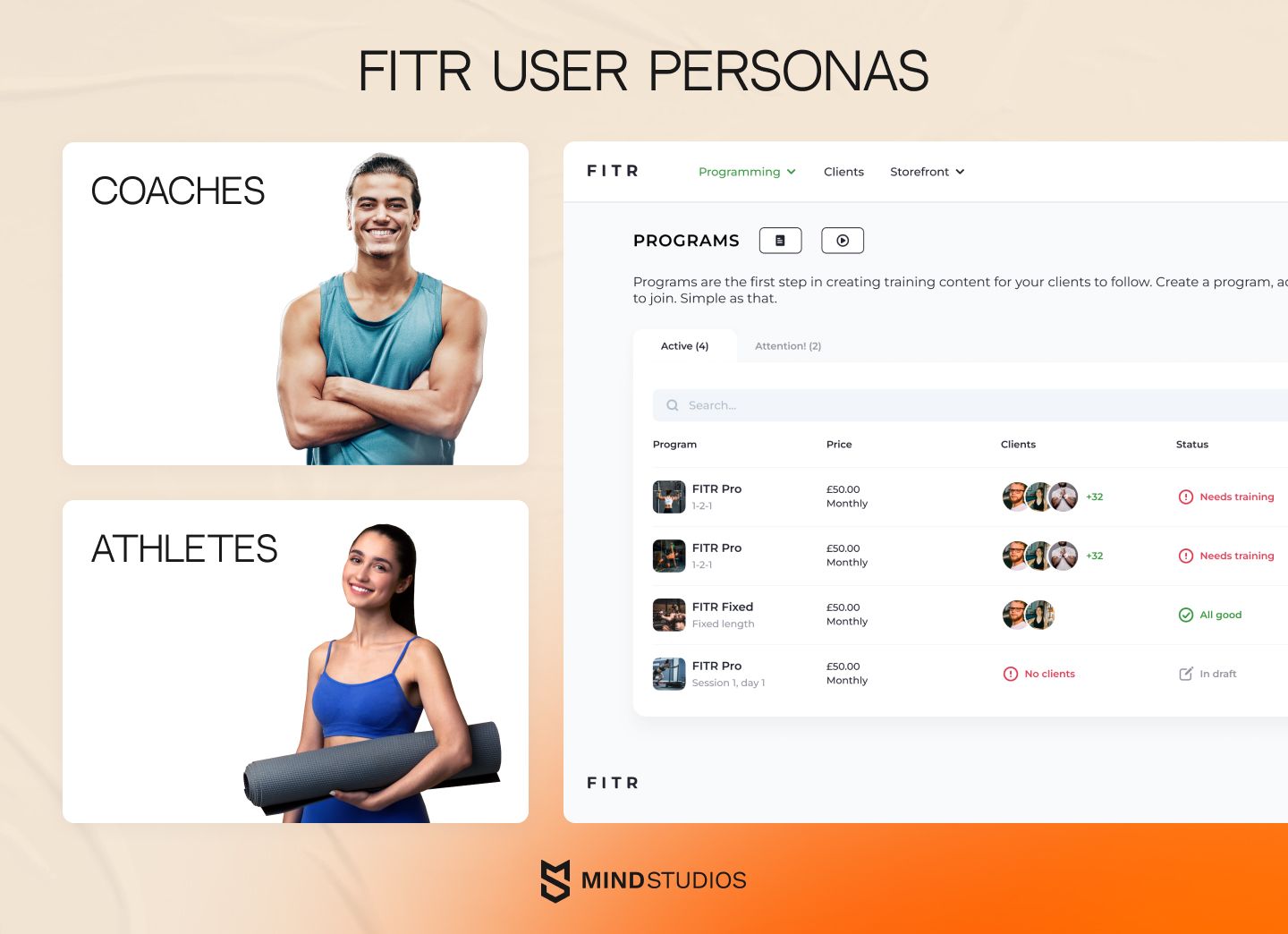
- Coaches wanted to easily track client progress across all programs, manage finances, and communicate with clients one-on-one and in groups.
- Athletes wanted an easy-to-use interface to watch training videos, search a vast exercise knowledge base, track their progress, and communicate with their coach.
Ultimately, we achieved user-centric design by aligning platform features with these personas. You can learn more about the project in our case study, where we explain the digital coach platform development process in more detail.
Online coaching software essential features and how to choose them
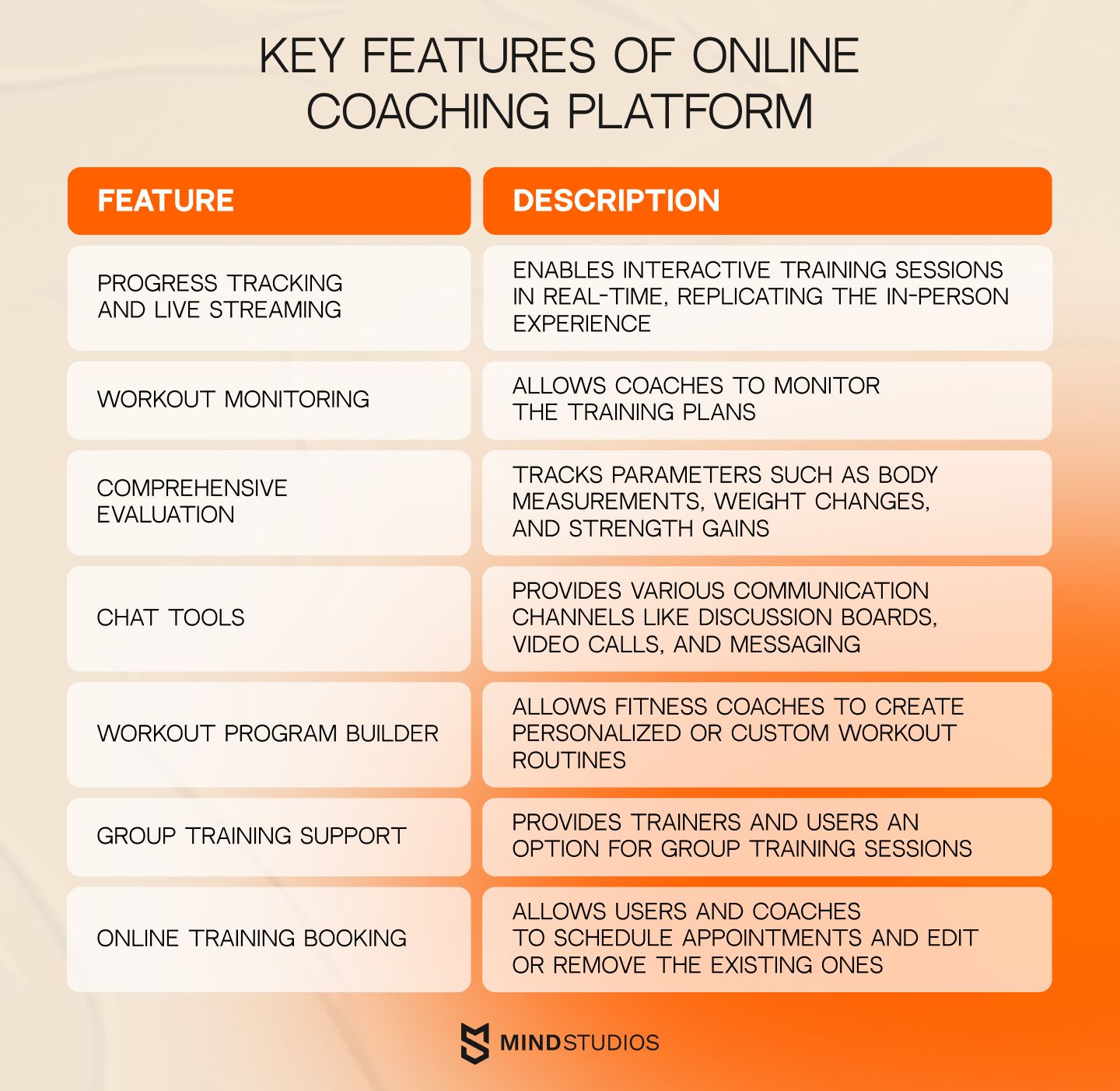
Once you have the product vision and concept figured out, choosing the core functionality is next on the list of crucial phases in the coaching platform development process, and in our experience, an online coaching platform can benefit from the following features:
Progress tracking and live streaming
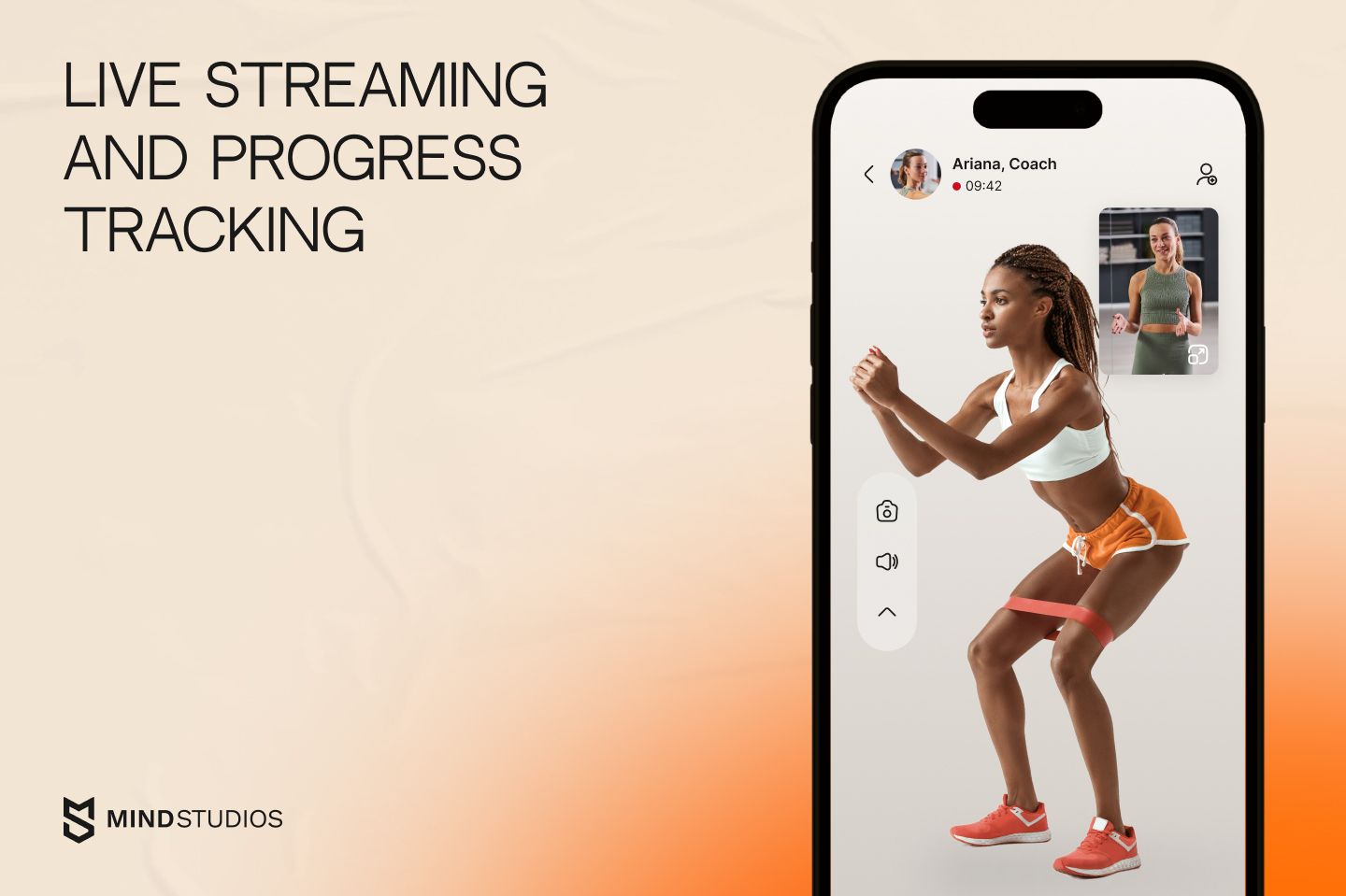
Progress tracking and live streaming allow online coaches to hold real-time interactive training sessions with clients. These features give clients personalized direction and responsibility like in-person training.
Coaching software with interactive features can motivate clients. Interactive features like virtual fitness challenges and live workouts keep users interested and motivated, improving retention and satisfaction. This may increase platform usage through positive word-of-mouth and reviews.
Workout monitoring
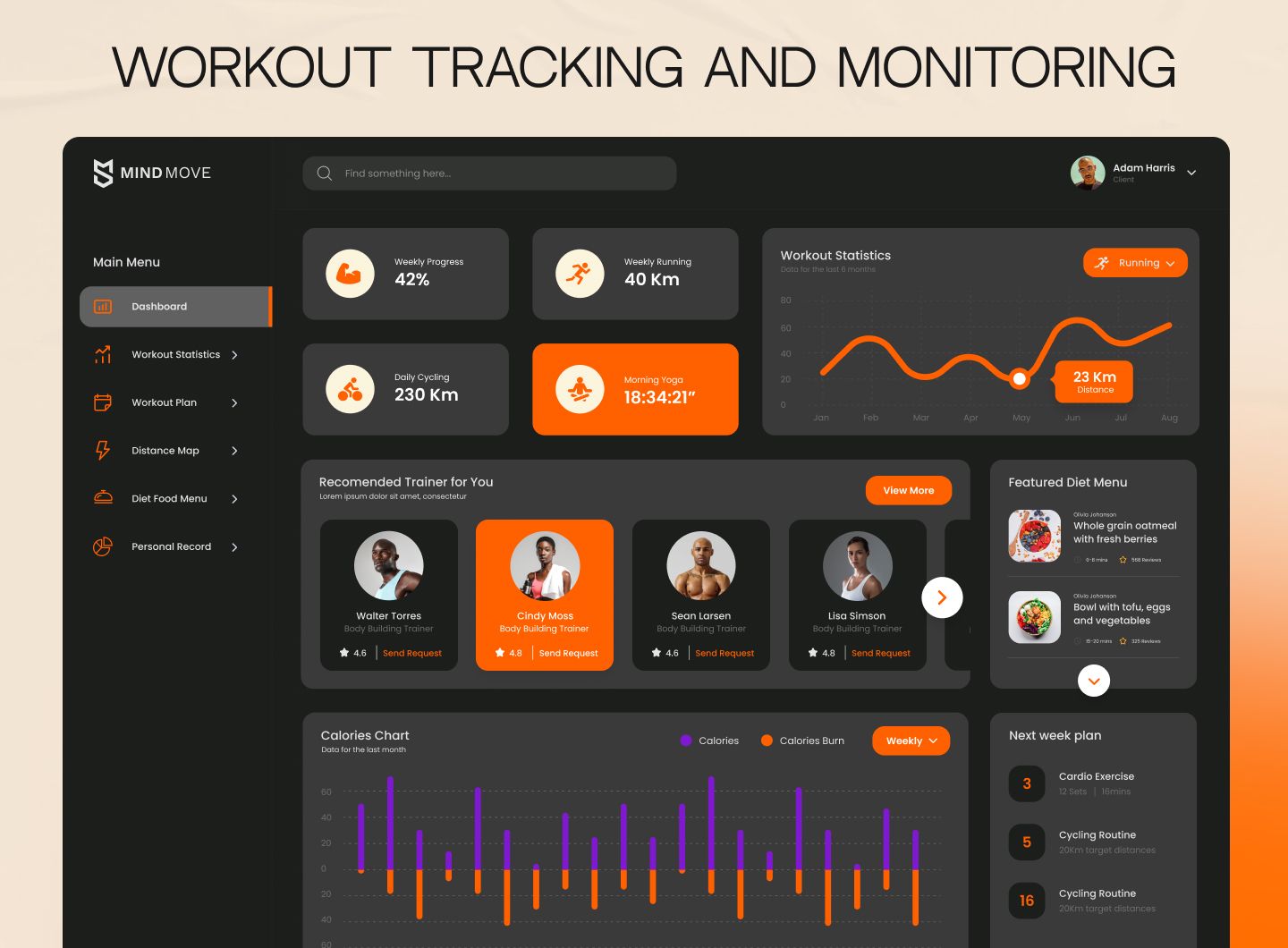
Workout monitoring is another important tool that helps you keep an eye on personalized training plans for users. This feature lets customers keep track of their progress, log their workouts, and record performance indicators.
In addition, the information gathered from tracking workouts can enhance the app's functionality and provide users with personalized recommendations, ultimately leading to a better user experience.
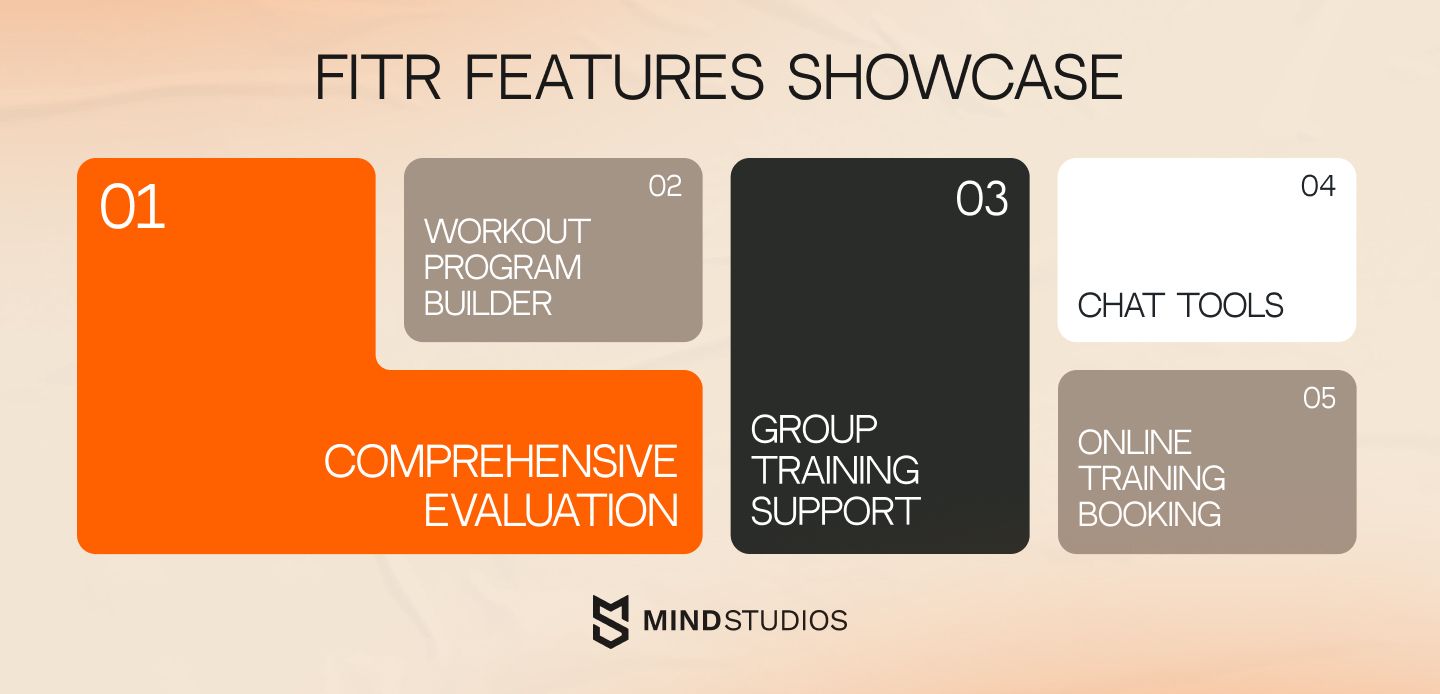
Comprehensive evaluation
Coaches can closely monitor and evaluate their clients' progress over time using technologies that track multiple parameters, such as body measurements, weight fluctuations, and other changes.
Strength gains and cardiovascular fitness improvements are just some of the metrics that clients receive detailed information about as they progress. Proof of progress can greatly enhance their motivation and dedication to their fitness journey, improving user engagement and retention. Likewise, the app's thorough evaluation features show that it can help users reach their fitness goals, which benefits the app's owner.
Workout program builder
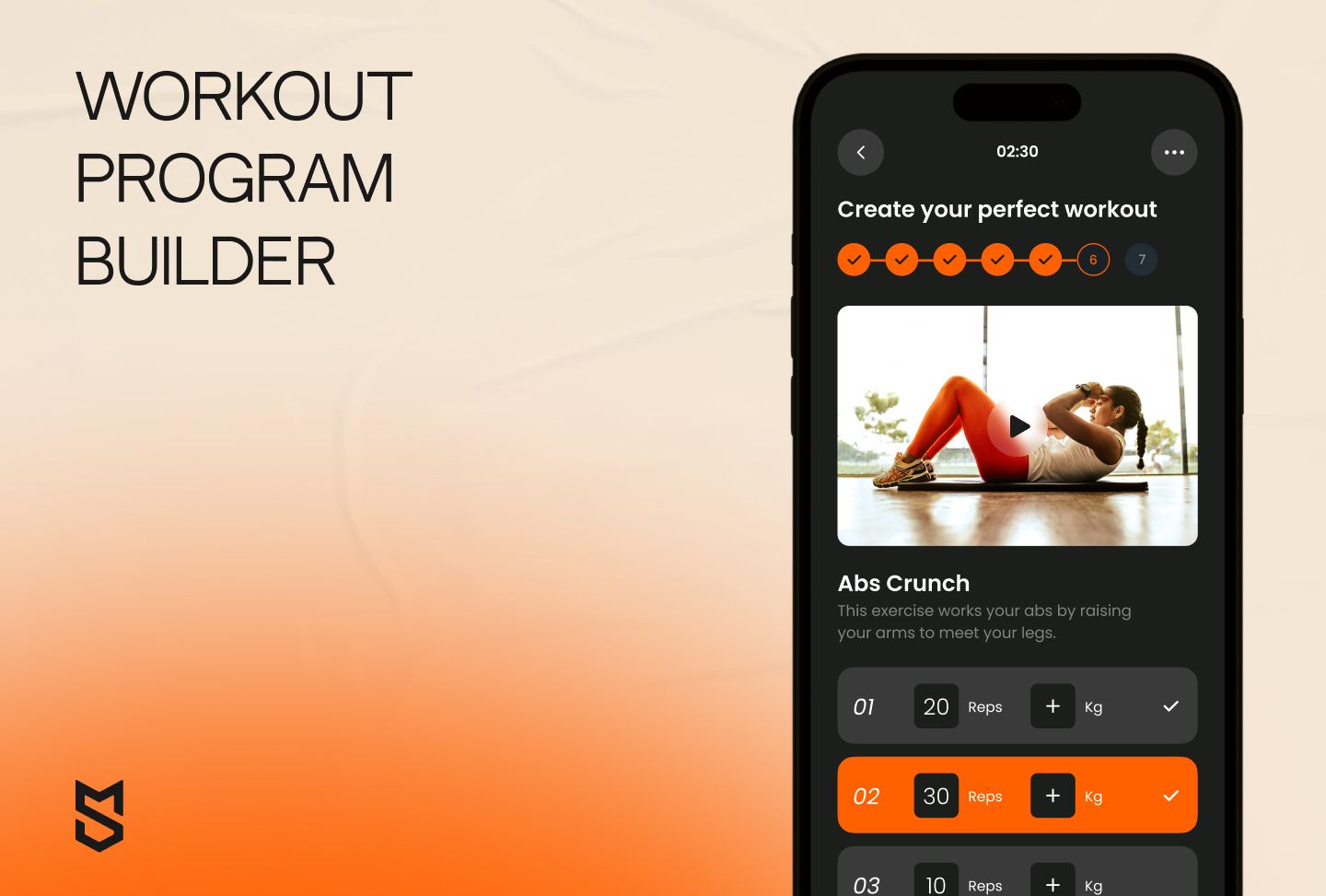
This functionality can help you streamline the planning process and enhance your ability to deliver targeted, effective training that adapts to your clients' goals. A complete fitness program builder is necessary because it lets you make workout plans, including different types of exercise, create schedules, and change how users work out.
An app with this feature will stand out as a valuable tool for fitness enthusiasts and professionals, thanks to its comprehensive workout program builder. Providing continuous value and support can draw in users looking for individualized training solutions and help keep them.
Group training support
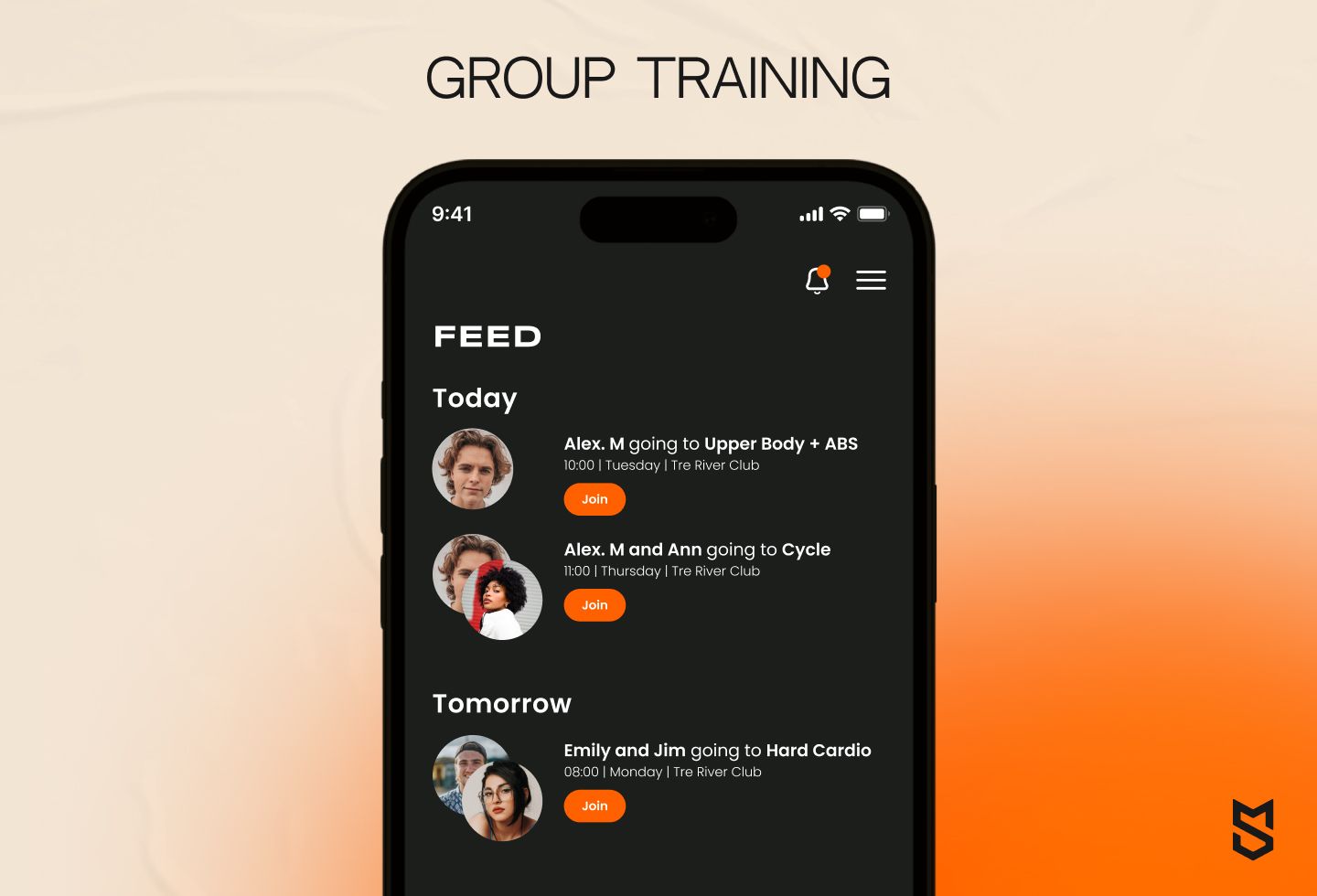
Group coaching is excellent for helping more people and building an engaged community around your business. Think of group challenges, exercises, and training sessions. Community is an essential component of fitness.
Leveraging this by adding group coaching capabilities to your software will help your virtual fitness platform become a source of motivation for many potential users in the long term. This feature is extremely beneficial since more people may be interested in community-based fitness activities if group training is an option.
Chat tools
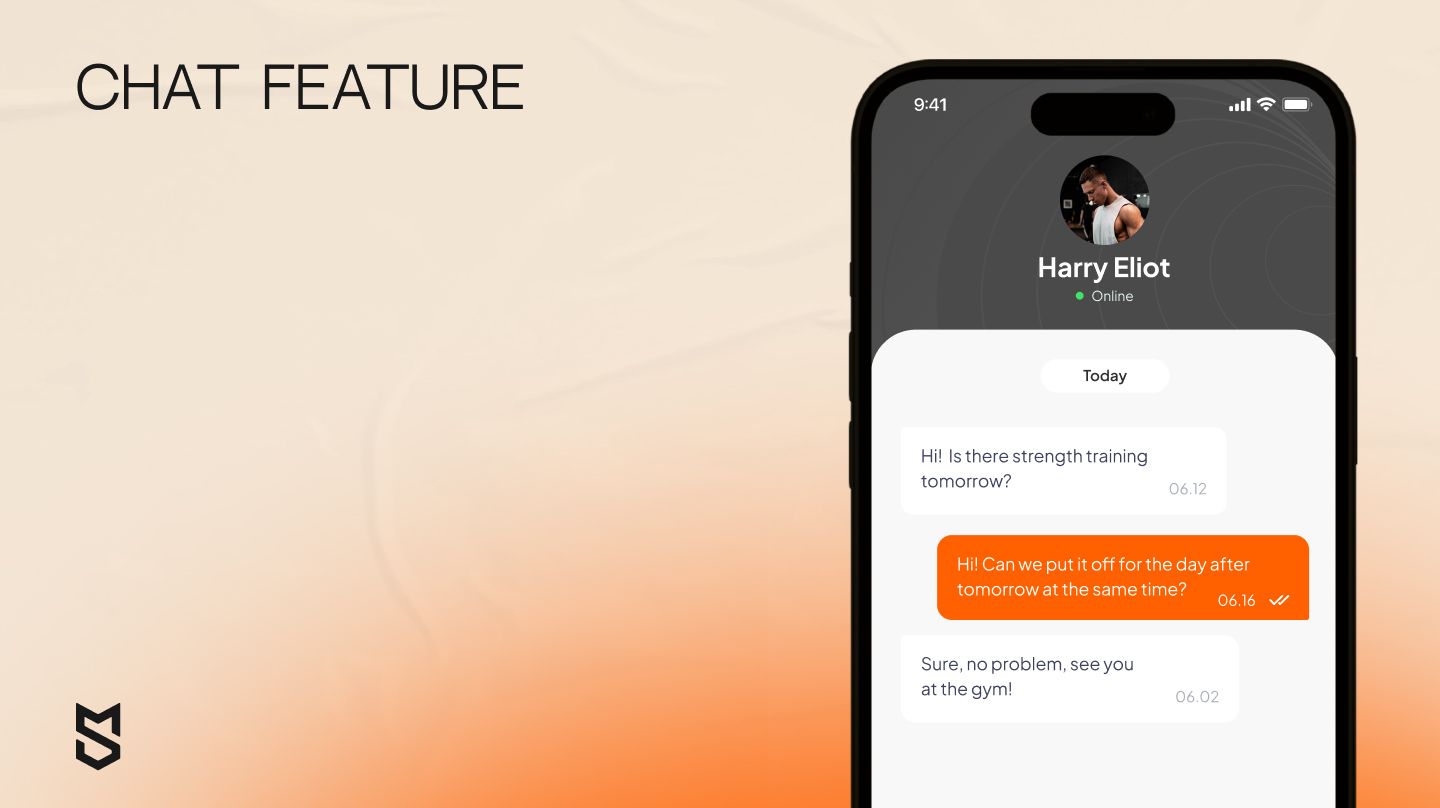
Having a chat or similar communication feature is integral to any remote coaching app. Chat tools let users and coaches get help when they need it. Staying in touch is important for any training-related talk, whether planning meetings, reviewing the training plan, or fixing technical issues. Likewise, it works both ways: Adding effective communication tools to software improves the whole user experience. Coaches and athletes expect the platform to have smooth communication methods, and meeting this goal when you create a coaching app makes users more satisfied and inclined to stick with it.
Online training booking
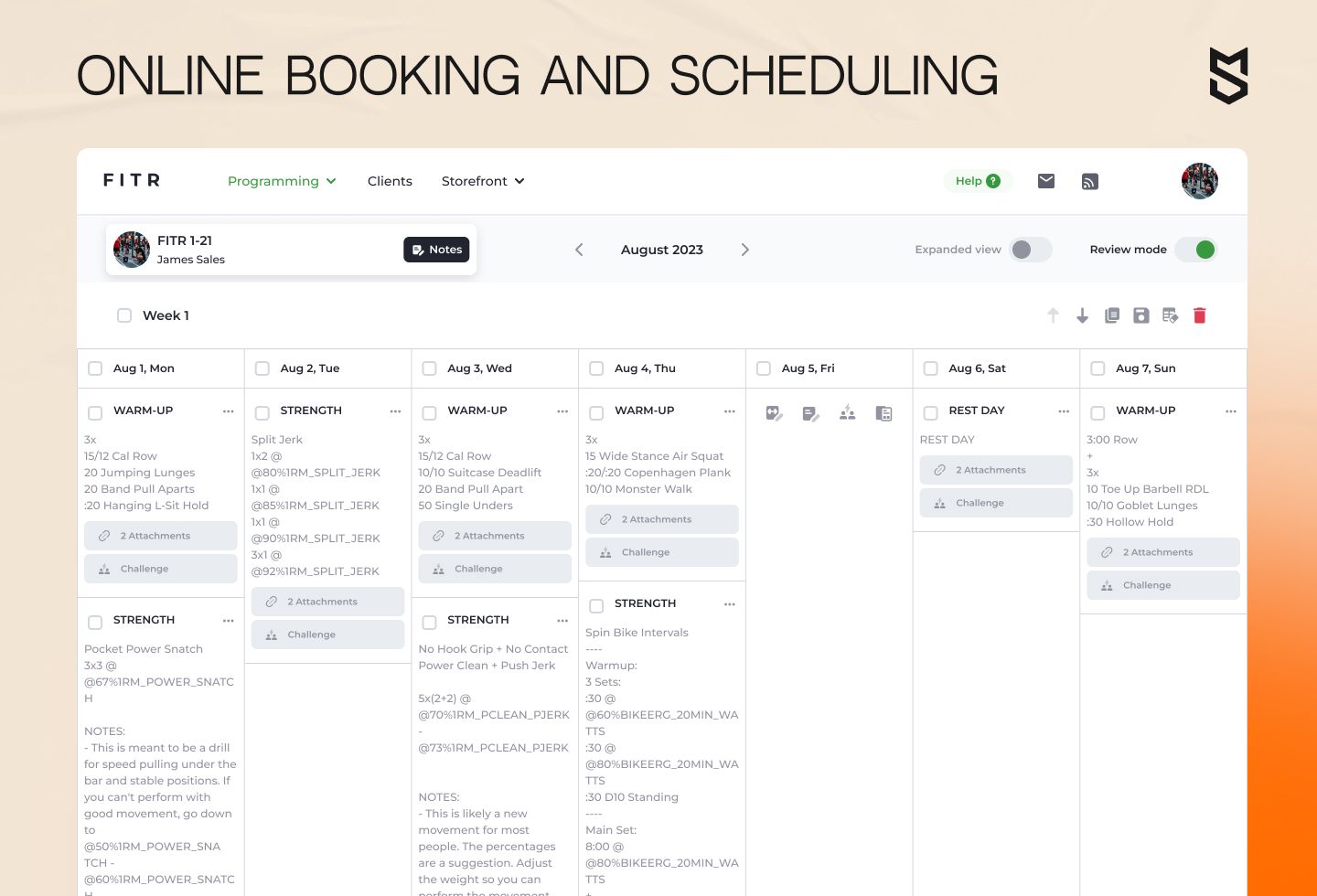
A crucial component of a fitness platform, online scheduling and payment for fitness services is a time and hassle saver for users. It also opens up fitness resources to a wider audience and allows for more customization.
The availability of online booking features enhances the user experience and operational efficiency.
It generates revenue for the app from service bookings and draws in users looking for accessibility and convenience. Also, it's useful for appointment management, which means less paperwork for coaches and managers.
Best practices for online coaching platform implementation
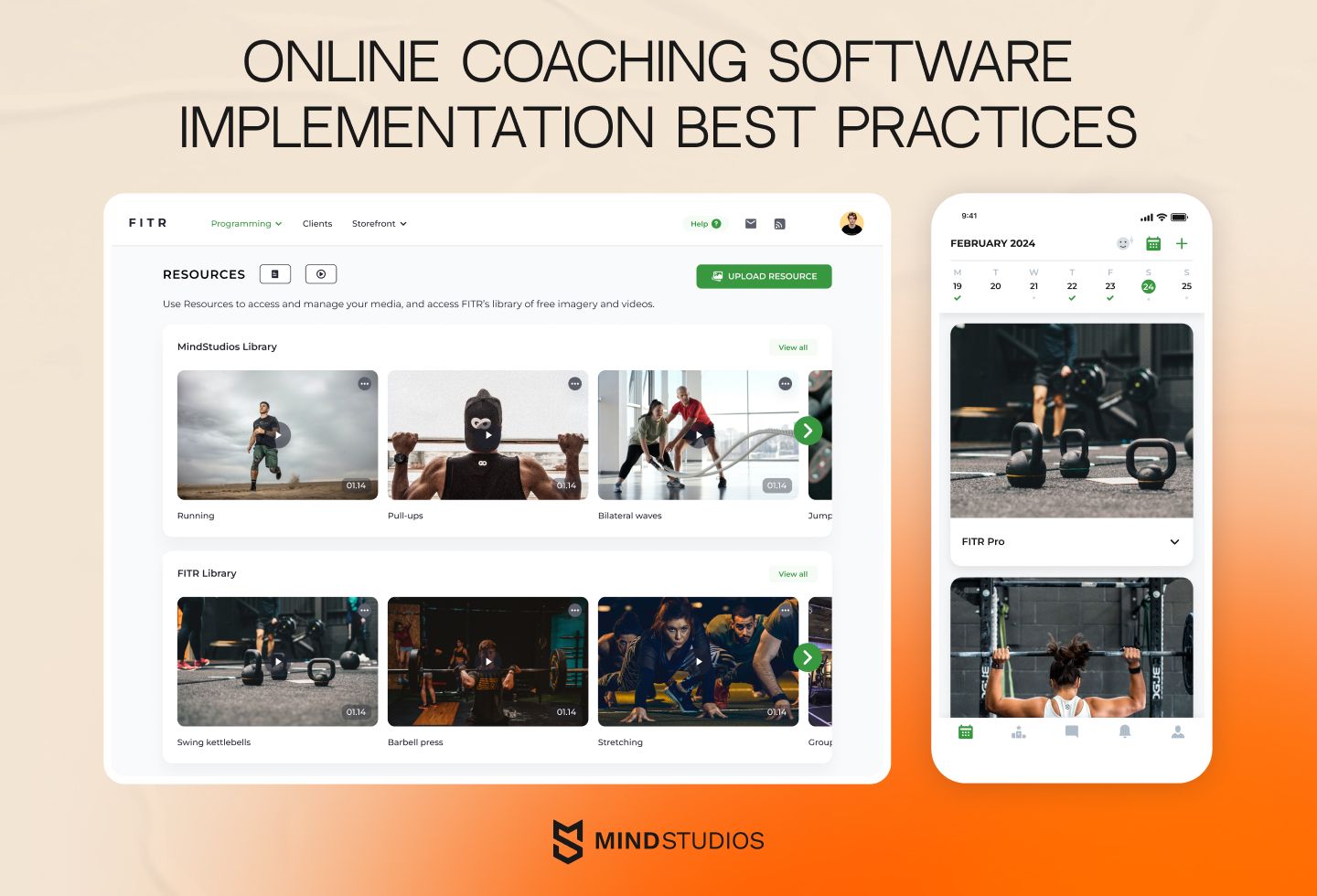
Users want personalized plans from coaches to get results, and having an excellent first experience is crucial. It takes careful planning and execution to get the most out of online fitness coaching software or a fitness app while avoiding common mistakes. The following are recommended practices we suggest exploring during the development.
Come up with an intuitive UI/UX design
Understanding user needs is the first step in creating an easy-to-use interface for online fitness coaching. By adding straightforward processes, appealing layouts, and easy navigation, we can make the platform more welcoming for coaches and clients.
We suggest increasing the program's cross-platform compatibility to work on all devices and browsers. By simplifying UI/UX, coaches can reduce user friction and improve the experience, encouraging long-term coaching software or app use.
Before you start to build a coaching platform, we also recommend researching the market and the requirements of real users during the pre-development phase, since it can take a lot of time. For instance, our UI/UX designer communicated with real coaches while developing the design for Fitr to ensure his hypotheses were valid. Here is an example of how your app could look like:
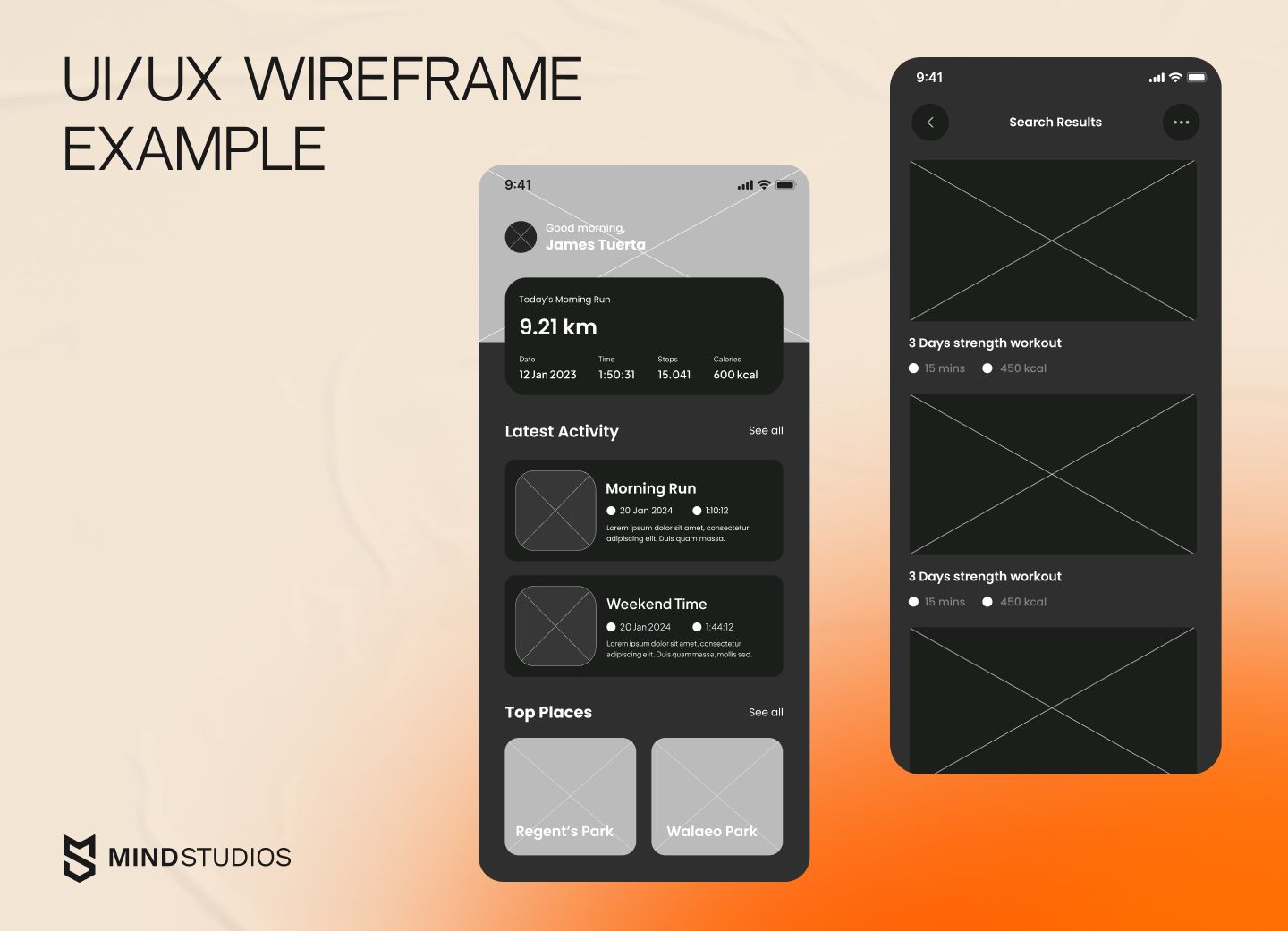
Integrate business management tools
While it's not a basic feature, we've found integrating comprehensive business management tools to be extremely rewarding. These tools have scheduling features for keeping track of client appointments and payment processing features for automated billing, invoicing, and payment tracking. This makes it easier to get revenue and reduces the amount of work that needs to be done manually.
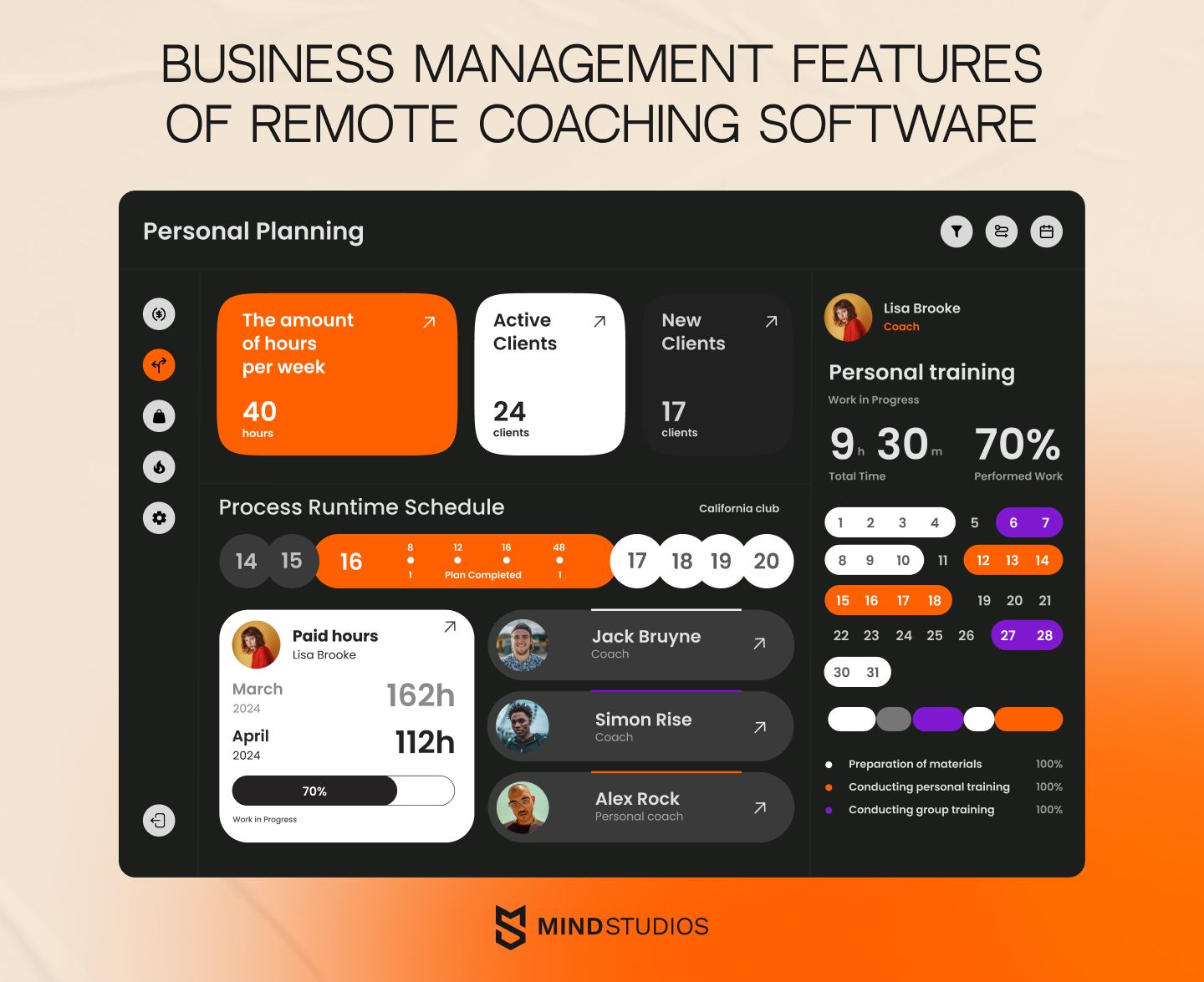
Putting business management in one place in the coaching software lets coaches focus on improving their programs and giving their clients the best instruction and support.
Don’t forget about security measures
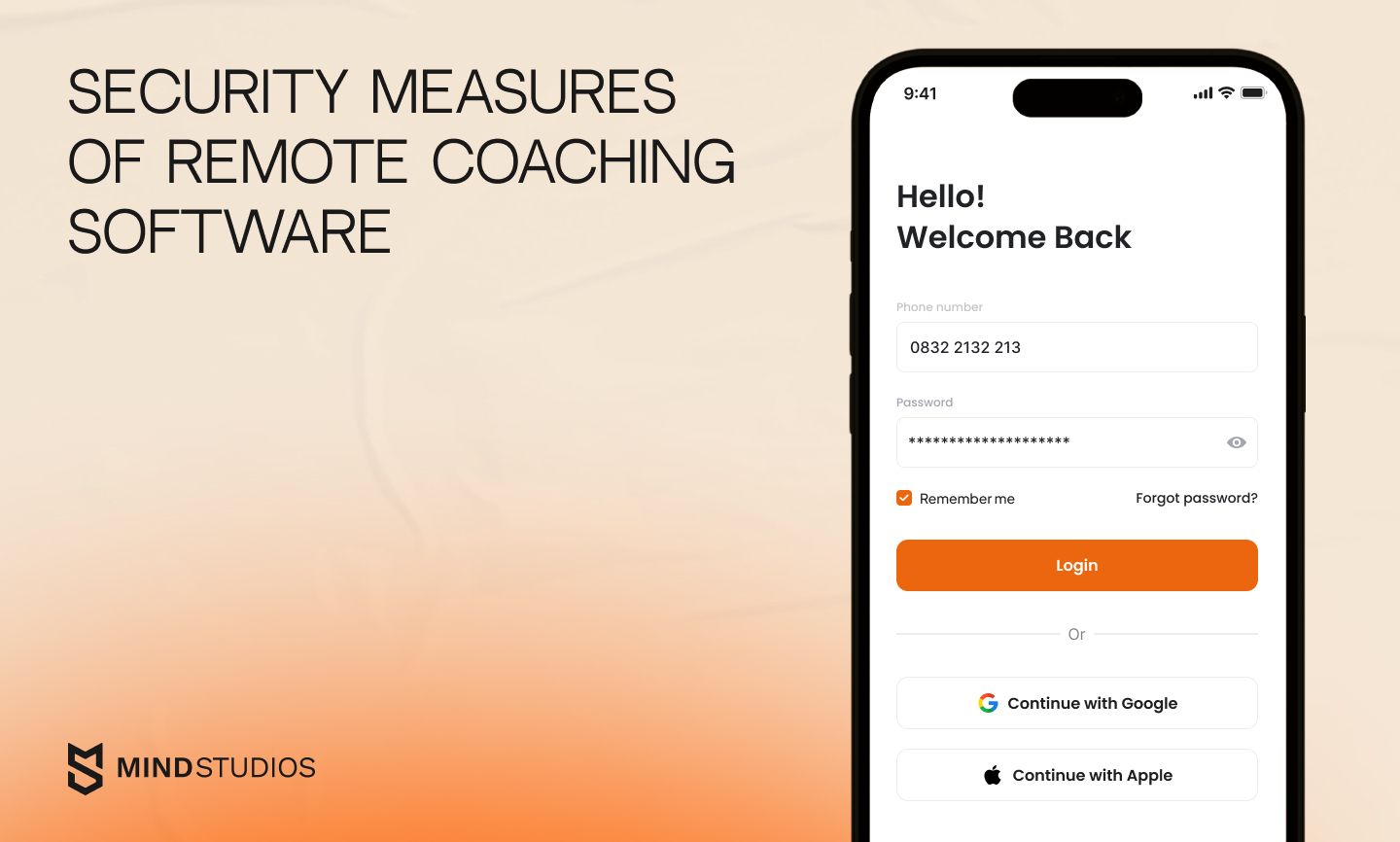
We always insist on prioritizing data security by implementing robust measures to protect sensitive client information stored in coaching software. This includes using industry-standard encryption techniques to secure data transfer and storage, implementing multifactor authentication to prevent unwanted access, and conducting security audits regularly to detect and address potential weaknesses.
Coaches prioritizing data security can foster confidence in their clients and demonstrate a dedication to preserving their personal information.
Add effective client communication tools
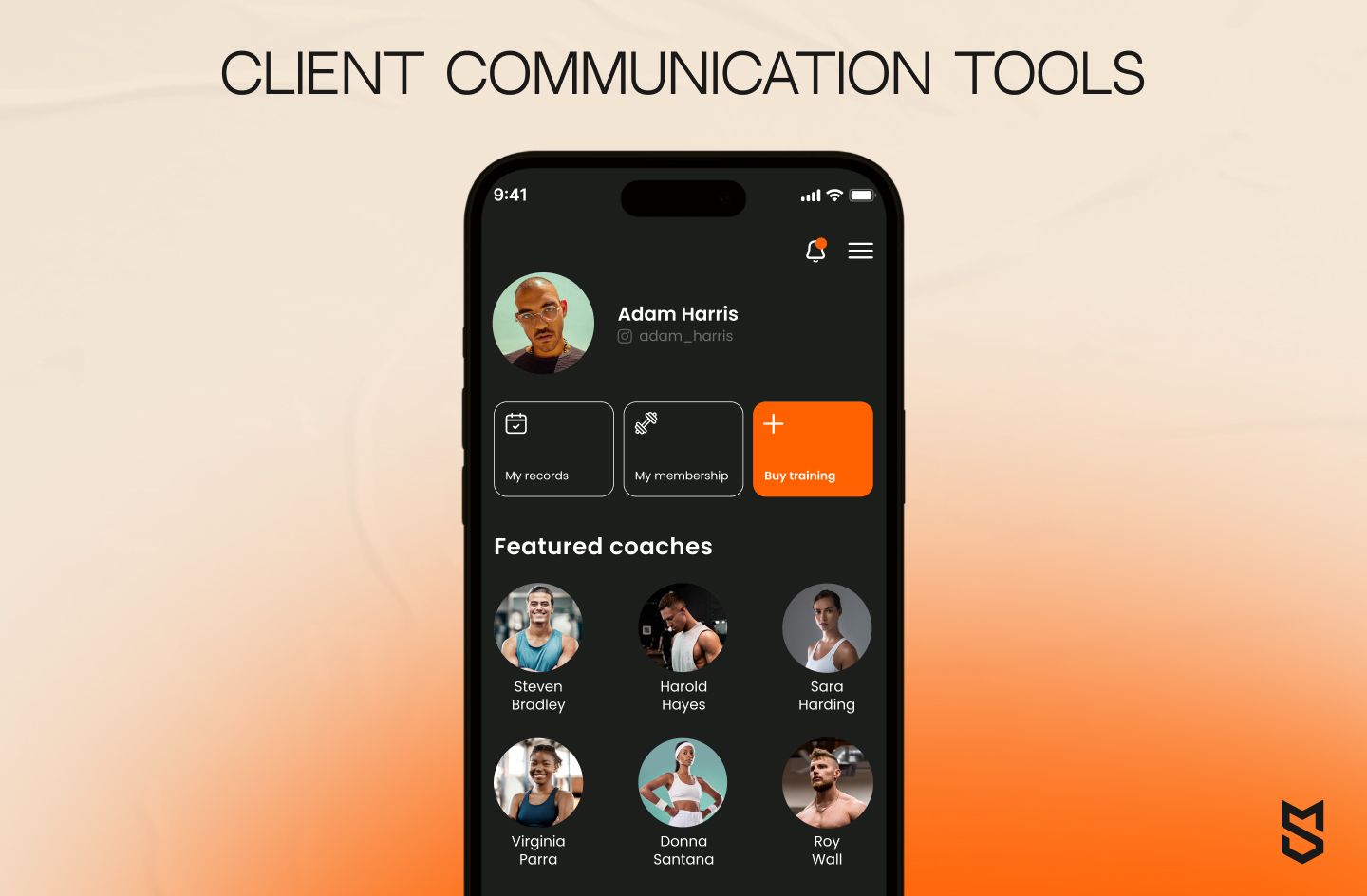
We recommend the coaching platform to have strong client management features so that users can get personalized help and instruction. Client profile management is one of the main features that helps coaches keep track of vital information like health concerns, fitness goals, and progress data.
If this information is centralized in coaching software, it can help coaches understand clients' needs. They can track clients' progress, provide personalized feedback, and customize training programs. If a coach sees a client isn't losing weight, they can adjust their diet or exercise plan via the platform.
Additionally, using feedback mechanisms to get customers' opinions on communication preferences and satisfaction help improve communication and identify areas for improvement.
Include wearable fitness device integrations
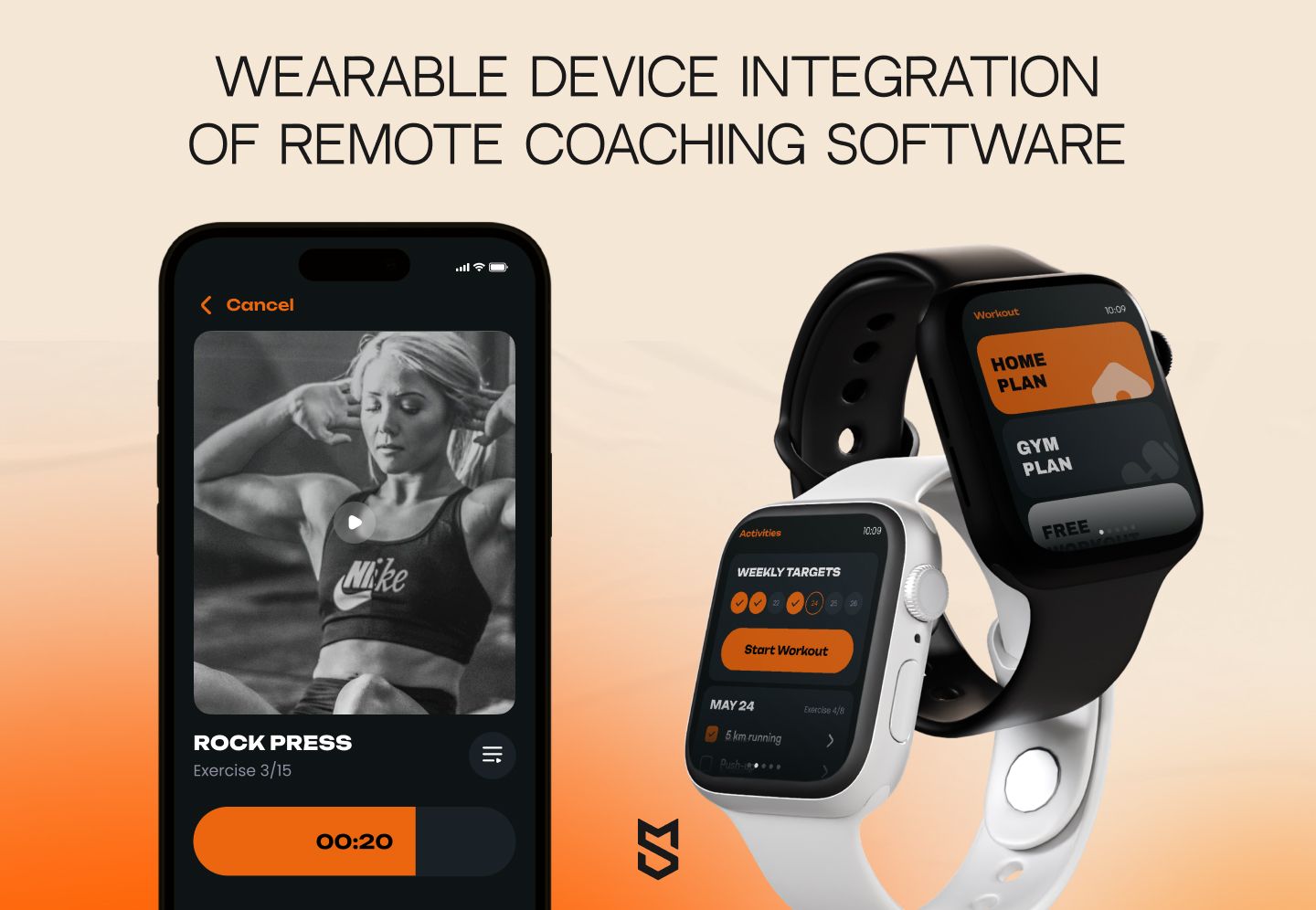
For coaching software, Mind Studios’ developers recommend conducting extensive compatibility testing to ensure the software and popular fitness trackers work seamlessly together. This is the list of things we recommend if you want to integrate wearable devices into remote coaching software:
- Identify popular fitness tracker brands and models that align with the software's target user base.
- Use the fitness tracker manufacturer's API for seamless data exchange.
- Implement real-time or periodic data synchronization between the fitness trackers and the software.
- Implement secure authentication mechanisms and adhere to industry standards.
- Design intuitive dashboards to display fitness tracker data and provide insights within the app or software.
- Set up systems to notify users and coaches about significant events detected by the fitness trackers.
- Offer user guides, tutorials, and troubleshooting resources for users.
- Monitor user feedback and analytics to identify areas for improvement.
If you need expert advice, Mind Studios will gladly provide it, since we have a proven track record of multiple fitness projects. Feel free to contact us, and we will schedule a free consultation with our specialists.
Choose the right monetization method for your project
Monetizing your app is another key part of app creation. You will need to pick the appropriate strategy to ensure your app makes revenue and will be around for a long time. Here are some well-known choices that we suggest:
| Revenue model | Description |
|---|---|
| Subscription-based model | Charge customers on a monthly basis |
| In-app purchases | Let users buy features and content |
| Advertising and sponsorships | Collaborate with other companies to display ads or promote items within the app |
| Freemium model | Offer basic features for free and charge for premium ones, based on any other model — subscriptions, or IAPs. |
| Paid app model | Require customers to pay upfront to get the app |
| Affiliate marketing and relationships | Work with other companies to get a share of ad revenue and sales made via referral programs |
| Revenue stream diversification | Blend online and in-person features with one digital platform to boost revenue |
It's important to ensure that your app's goals fit with the plan or strategies you've chosen. If you need assistance determining the optimal monetization method for your online coaching platform, the business analysts at Mind Studios are here to help.
How our clients profit from coaching platforms
Being one of the most long-running projects of Mind Studios, Fitr offers a variety of options for both coaches and athletes. For around two years after its launch, coaches could use the Fitr app for free. After introducing a subscription option, we observed how many newcomers who joined the platform in August 2020 would stick around beyond the trial period and purchase a subscription.
“The number of new sign-ups dropped — we expected that. But the number of users unsubscribing was extremely low. Moreover, a couple of coaches even bought yearly subscriptions right away. That’s when I knew we did a good job.”
— Anton Shatalov, Mind Studios’ COO
Later, the statistics on our coaches' lifetime value (LTV) proved right. Of every 100 coaches that join up for Fitr, around 50 still use it a year later. Combining a high-quality product and diligent work allowed us to accomplish this goal with a low churn rate.
Challenges while building a remote coaching platform, and how to solve them
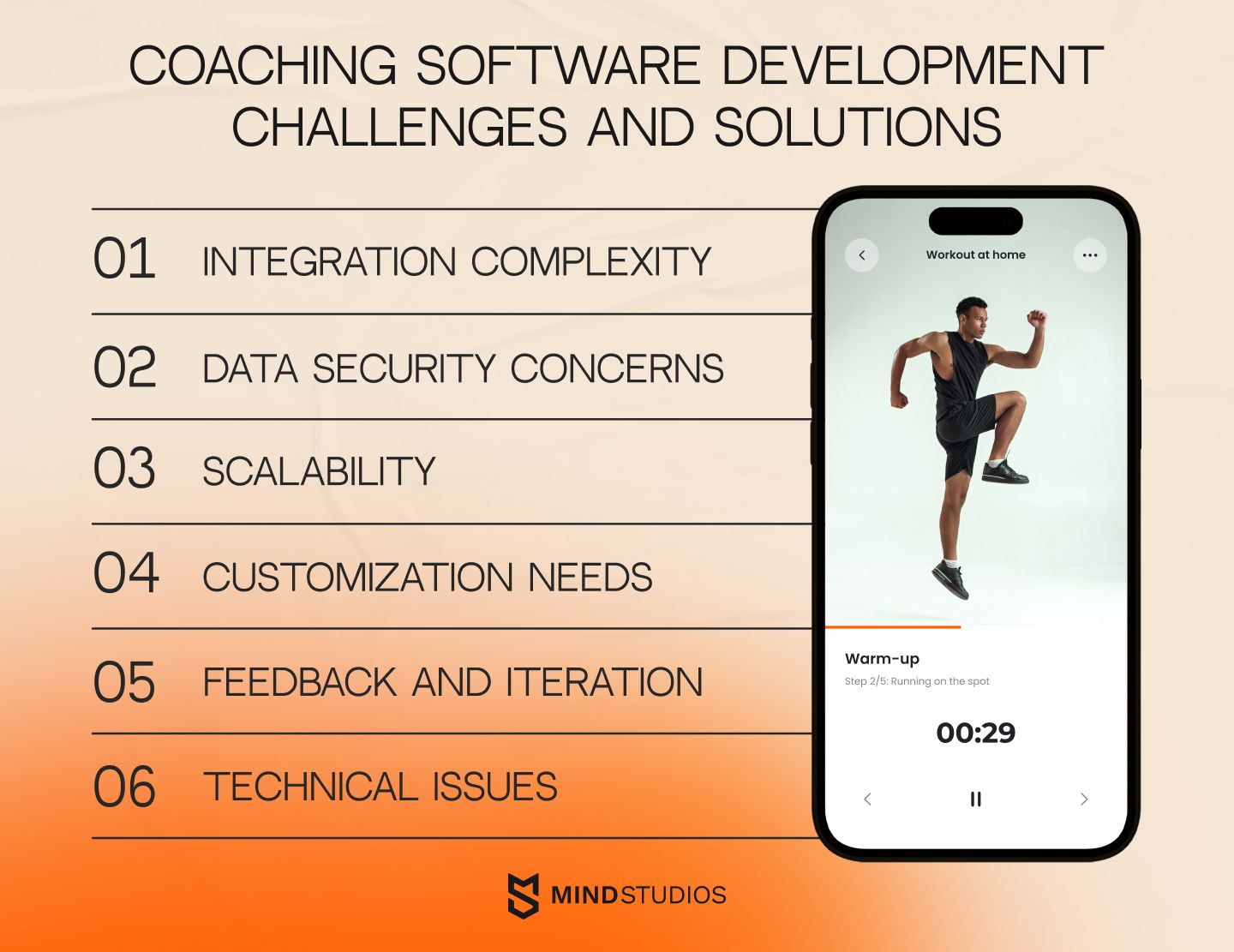
Building an all-inclusive online coaching platform that can accommodate users, trainers, and even large fitness and gym chains is no easy task. The most typical problems that could crop up throughout development, along with suggestions for fixing them, are detailed below.
#1 Integration complexity
Integrating many tools and platforms, such as exercise trackers, video streaming, and payment systems, may be complicated and time-consuming. Each integration needs extensive testing to guarantee flawless interoperability and data sharing across systems. Compliance with new APIs and third-party software changes can complicate the integration process.
Solution: Prioritize unified platforms or solutions with pre-built integrations to facilitate integration. This will cut down on development time and ensure that interoperability runs more smoothly. Additionally, automating testing processes will ensure data sharing is effective and quickly address any compatibility issues.
#2 Data security concerns
Handling sensitive health and personal data necessitates strong security safeguards to ensure compliance with requirements like GDPR (General Data Protection Regulation) or similar.
Solution: Encrypting data in transit and at rest, imposing access restrictions, conducting frequent security audits, and always staying current on security best practices are critical for reducing the risk of data breaches and protecting user privacy.
#3 Scalability
It is imperative to ensure that the program can handle a rising user base and data volume while maintaining performance and dependability.
Solution: To accommodate higher demand without losing speed, software architects must build scalable infrastructure, optimize database queries, and integrate caching methods. Regular performance testing and capacity planning are required to predict and handle scaling problems early.
Moving to AWS is an example of a situation in which we were unprepared but managed to find a solution. Because Fitr grew quickly and was vulnerable to security attacks, Mind Studios successfully relocated it to an AWS server. The migration resulted in a more secure and reliable platform, improving system response by 85.5% and eliminating errors.
#4 Customization needs
In a case when you build an app for multiple coaches, they may have special needs for modifying the software to match their coaching methodology and branding, adding complexity to development.
Solution: Offering changeable settings, customized templates, and white-labeling options allows coaches to personalize the program to their own preferences and branding rules.
#5 Feedback and iteration
Continuous user input is critical for refining and developing software over time, necessitating a flexible development style that allows for incremental upgrades.
Solution: Setting up easy ways to obtain customer feedback, like surveys, feedback forms, and user forums, helps you ensure you're continuously improving your software. We focus on what our users tell us they need, which is crucial for making the software better and keeping users happy.
#6 Technical issues
Providing continuous technical support and maintenance to resolve issues, updates, and user concerns necessitates a committed team and experience.
Solution: Building a support infrastructure is key to keeping your product reliable and functional over time. This means setting up a ticketing system, creating a helpful knowledge base, keeping timely communication channels, and regularly updating and fixing the software.
How much does it cost to build a digital coaching platform with Mind Studios?
As you can see, creating a fitness coaching app for mobile devices is not a simple task. The intended users, level of design complexity, features required, and platform all affect the cost of creating an online fitness app or platform.
Here is a rough estimate of the time and cost needed to build a remote coaching app from scratch.
| Stage | Time, hrs | Description |
|---|---|---|
| Android app | 900+ | $40 500 |
| iOS app | 900+ | $40 500 |
| Front-end (website) | 600 | $27 000 |
| Backend | 800+ | $36 000 |
| UI/UX design | 220+ | $9 900 |
| Testing + project management | 680 | $30 600 |
| TOTAL | ~4,100 | $184 500 |
We can roughly estimate the cost of a remote coaching app to be $-and upwards. Wonder how much your idea will cost if Mind Studios implements it? Contact us today, and we will schedule a free consultation and provide an estimate for it.
Conclusion
Modern fitness coaching relies on personal coaching software to boost efficiency. Digital coach platform development isn’t easy but this solution streamlines program design, progress tracking, client management, and communication for trainers. Likewise, online coaching software allows trainers to create workout plans, manage client profiles, and schedule sessions from a single platform. Implementing such a solution can be difficult, so you may need an expert opinion.
Here at Mind Studios, we know what it takes to build all-inclusive solutions for fitness professionals while keeping the average user's needs in mind. Is this the kind of solution you'd like? Reach out to us, and we'll arrange a free consultation with one of our specialists.

